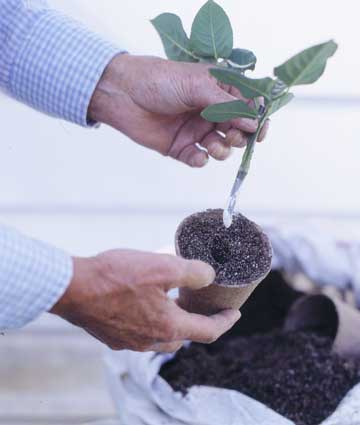





 Although transplating and cuttingare not foolproof, cuttings maybring you the greatest success.
Although transplating and cuttingare not foolproof, cuttings maybring you the greatest success.
The easiest way to expand your rose collection is to order new plants from a nursery. But if you want to experiment with asexual propagation, you can dig up and transplant rooted shoots that emerge next to a mother plant, or take cuttings from the plant itself.
continue reading below1. In late spring or early summer, cut a vigorous cane that has lost its blooms. Take about 6 inches off the top, removing old flower heads. Cut the remaining cane into 6-inch pieces, using sharp-angle cuts. The bottom of each piece should be cut as close as possible to a leaf node (where leaves form), with no more than two leaflets attached to each cutting. Dip the bottom 1 inch of the canes into rooting hormone powder and plant them; or submerge the bottom ends in willow water, allow them to sit overnight, then plant.
2. Place each cutting in a 6-inch peat pot filled with a moist mixture of equal parts sand, perlite, and sterile potting soil. Mist the cutting, place a plastic bag over the pot, and secure the bag in place. Keep cuttings outdoors in a bright spot that's shaded during the hottest part of the day. Water cuttings periodically to keep them moist but not wet. When rooted (generally within a month), transplant the cutting, pot and all, to a permanent spot in the garden. The peat post will deteriorate over time. Willow water is a natural root-promoting solution made by soaking chopped-up willow twigs in a bucket of water overnight.
Copyright © www.100flowers.win Botanic Garden All Rights Reserved